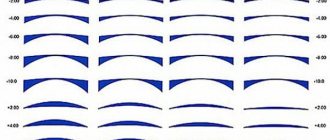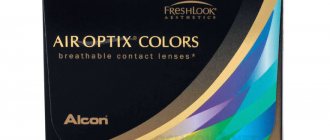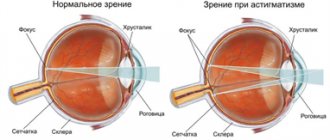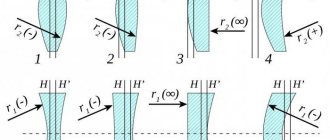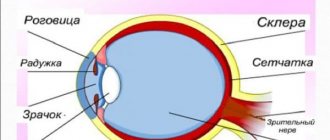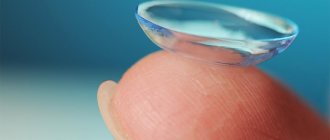Tinted lenses and their features
How to choose colored lenses for gray, blue, brown or green eyes? In fact, there is no universal instruction; each patient needs to be guided by his own feelings and wishes. However, before heading to a specialized store to make the desired purchase, it would be useful to get acquainted with the main types of such products.
When answering the question of how to choose colored lenses for blue eyes, it is necessary to describe in detail the so-called tint lenses. These devices are ideal for all owners of light eyes (not only light blue, but also green, light gray). Their distinctive features are the following characteristics:
- Translucency of the colored pigment of the material.
- Lack of drawing.
- Slight staining of the pupillary area, which does not interfere with vision.
The main purpose of such lenses is not to change color; they are not capable of this. The devices only give the eyes greater brightness and emphasize the existing shade. The final effect looks quite natural, but much more expressive. It should be noted that if the iris has a bright, pronounced shade, this option will not work.
Colored lenses and their features
How to choose colored lenses for green eyes? If you are lucky enough to have bright emerald eyes, then tinted lenses will not be the right solution. Bright greens or blues, as well as light brown shades, cover classic colored lenses well. This category has a very wide range and variety of models. It is quite simple to distinguish them from the option described above; they are less natural and are often easily identified by outsiders; the products have a colored pattern in the form of a pupil on the lens. The purpose of such products is to enhance the natural color or radically change it.
Special lenses for dark eyes
Are colored contact lenses suitable for dark brown eyes? In this case, choosing a suitable product is quite problematic. In this situation, most or almost all lens shades look unnatural and are immediately noticeable to others. That is why it is recommended to give preference to special models with a dense pattern that can cover up the natural bright color. By the way, such lenses can be worn by all other people, but in this case a natural effect will also not be achieved.
Lens curvature index
Only an experienced ophthalmologist can answer what the lens curvature index is for each individual person. In humans, the corneal curvature of a standard eyeball size is 8.6. To accurately determine it, it is necessary to undergo computer diagnostics, which will determine the radius of curvature, the degree of astigmatism and other parameters.
If the radius of curvature of the cornea differs from the standard sizes, then contact lenses will need to be made to order. Otherwise, a person will feel discomfort in the eyes, inconvenience and deterioration of vision instead of its planned improvement.
Universal tips for choosing colors
So, you've decided that you need colored lenses. How to choose a color? The universal advice in this matter is naturalness; the shades of the product should, although bright, be as close as possible to your native, natural color. With obvious transitions (from light to dark), this will be very noticeable to others. When choosing a shade, be guided by the following recommendations:
- Study the instructions: as a rule, it indicates for which eyes the lenses are suitable (dark, light, universal option).
- Light eyes allow the use of tinted lenses.
- Dark eyes are not covered by tinted lenses; they require products with a dense pattern.
If you have not decided on the appropriate color, try to select it in a special computer program, simulating several options and determining the most suitable one for yourself.
LiveInternetLiveInternet
Hi all!
This article is a direct guide to the selection of spherical soft contact lenses both for professionals - specialists in the field of contact correction and for clients/patients who would like to have an idea about the truly “professionally correct” selection of contact lenses.
Selection procedure
- Assessment of refraction and a complete examination of the eye, recording control indicators, identifying possible contraindications for wearing contact lenses;
- Keratometry/Topography;
- Selecting a trial lens (replacement frequency, brand, etc.);
- Selecting the base curvature, diameter and optical power of the trial lens (taking into account vertex correction);
- Fit assessment;
- Patient training (skills in putting on and removing lenses, timely replacement of lenses, care for them) and informing him (what to do in cases...).
When the lens fits well
- Comfortable;
- Well centered even when looking up with full coverage of the limb;
- Move adequately and gently in all directions of gaze, even when blinking;
- Easily move during push-up testing;
- Keratometric marks are visible clearly and sharply immediately after washing.
When seated flat
- May have difficulty centering, especially in peripheral gaze directions (i.e. sideways and up and down);
- Possible instability of vision immediately after blinking (while the lens is still decentered);
- May cause discomfort (feeling of the edge, unevenness of the lens, etc.);
- Choose a steeper lens radius or larger lens diameter (if possible).
During a steep landing
- Inadequate movement when blinking freely (although thin contact lenses may have normal movement, check with a push-up test);
- Difficult to move during push-up test through the lower eyelid;
- May cause compression and whitening of the vessels of the limbal conjunctiva (this should always be avoided, since such cases can lead to corneal complications);
- Choose a flatter lens radius or smaller lens diameter (if possible).
Fit assessment
- After 20 minutes or more. (When selecting Dailies, the fit is assessed after 5 minutes or after 2 hours, because in the intermediate period the fit may seem too tight);
- Fit is assessed based on the criteria of “good fit”.
Over-refraction
- When choosing the optimal sphere power that provides the highest visual acuity, be especially careful when choosing lenses with high negative diopters;
- If visual acuity is unstable, optimal fit cannot be achieved or cylindrical correction is required.
Patient education and information
- Educate the patient about the importance of hygiene when handling contact lenses and touching the eye;
- Teach the patient how to put on and remove lenses;
- Explain to the patient the benefits of timely lens replacement according to the selected schedule;
- Explain to him how to care for his lenses after choosing the appropriate care product (see “Recommendations for caring for lenses”;
- Tell the patient what to do if questions arise and when to contact a doctor immediately;
- Explain the need for follow-up inspections and set a date for the next inspection.
“Articles” series of messages:
Part 1 - What you need to know about wearing contact lenses Part 2 - How to properly put on contact lenses... Part 11 - Precautions when wearing contact lenses Part 12 - Dispelling myths about contact lenses! Part 13 - Contact Lens Selection Part 1: Spherical Soft Lenses Part 14 - Contact Lens Selection Part 2: Toric Soft Lenses Part 15 - Secrets to Successful Contact Lens Wearing... Part 33 - Contact Lenses for Children Part 34 - Environmentally Sensitive Contact Lenses Part 35 - Contact lenses - for many years
Enlarged pupil effect
There are also very original lenses that not only change the color of the eyes, but also give them the effect of enlarging the pupil. Korean manufacturers offer a wide range of similar products; similar lenses differ not only in color, but also in diameter. How to choose colored lenses by size? The following models are currently available for purchase:
- 14 mm. Have no additional effects.
- From 14.2 to 14.3 mm. Natural magnification effect, barely noticeable to the prying eye.
- About 14.5 mm. Natural but more significant enlargement effect.
- From 14.7 to 15 mm. The specific effect of puppetry, the pupils are greatly enlarged, this clearly catches the eye of others.
Large-diameter lenses are scleral and cover the entire visible surface; they should not be used for aesthetic purposes; wearing the product for more than 3 hours at a time is prohibited.
Measurement methods
The following parameters are studied:
- Curvature of the cornea: The eye doctor uses an instrument called a keratometer to determine the curvature of the clear front surface of the eye (cornea). This helps the doctor select the curve and diameter of the lenses. The surface of the eye may be slightly irregular due to astigmatism. In such cases, the doctor writes a prescription for special “toric” lenses. If the curvature is too flat or too steep for the eye shape, you may experience discomfort or even damage your eyes.
- Surface assessment: The health of the cornea is assessed using a biomicroscope (slit lamp). This illuminated instrument provides a magnified view of the cornea and other tissues so the eye doctor can evaluate the condition and detect abnormalities caused by wear.
- Tear film assessment: To wear all types of lenses, there should be no problem with tear film to ensure they are sufficiently hydrated. The ophthalmologist will place liquid dye on the eye to make the tears easier to see using a slit lamp.
Product radius
In order for the product to adhere clearly to the cornea, it is important to choose its radius correctly.
A measure of an important lens parameter in optometry (abbreviated BCR or BC). Curvature of the posterior surface and is sometimes referred to as posterior central optic (abbreviated BCOR). Typical values are between 8.0 and 10.0 mm. The base curve is the radius of the sphere at the back of the lens that the prescription describes (the lower the number, the steeper the curve of the cornea and lens; the higher the number, the flatter). Correct determination of the radius is important to ensure that the contact lenses fit well on the cornea. This is essential for ensuring the transfer of oxygen and the functioning of tear exchange.
Lens diameter
DIA stands for diameter. This is the distance measured in millimeters from one edge of the eye lenses to the other edge. The diameter determines the location of the eye. The diameter is determined by measuring the cornea. If it is not correct, it can cause irritation or even abrasions. A deviation of even 0.1 mm will affect the correct fit.
Basic recommendations for choosing a product
There are also general recommendations on how to select colored lenses. So, experts recommend paying attention to the following nuances:
- The integrity of the surface of the product, its appearance, the absence of defects.
- Reason for use (for daily wear - natural colors, for holidays - bright and original).
- Skin color (with a white tint, delicate, discreet colors, for example, blue or green, look organic; dark, rich tones, including sapphire or amethyst, are suitable for dark-skinned people).
When initially choosing a product, give preference to disposable products to evaluate how comfortable wearing them will be for you specifically. If you do not experience discomfort, it would be logical to purchase reusable lenses for long-term use.
One more nuance: do not focus only on brands and reviews, of course, such information will be useful when choosing, but your inner feelings are much more important than the opinions of outsiders. Another good tip is to get a recommendation from an eye doctor. Only he will be able to determine whether you are allowed to wear colored contact lenses, and will also recommend the most suitable model.
Possible contraindications and restrictions
It is extremely important to know not only how to select colored lenses, but also in what cases wearing them may not be recommended. It should be noted that such products are hydrogel, which means they do not allow oxygen to pass through to the eye cornea. Regular wearing of such lenses leads to damage and the development of hypoxia and vascular sprouting. Due to such unpleasant side effects, a contraindication to the use of devices is under 18 years of age. In order to prevent unpleasant consequences, it is recommended to coordinate the wearing of lenses with an ophthalmologist, regardless of the patient’s age.
Flat lens fit
If a person has a flat lens fit, then the following symptoms are observed:
- when a person looks left, right, up, down, the lens is centered somewhat late, that is, for some time the person is left with uncorrected vision;
- the same thing develops when blinking. Since the lens is centered too long, the view is greatly impaired;
- the eyelids feel the touch of the edges of the lens, which can cause severe discomfort.
To straighten a flat fit, choose lenses with a larger radius of base curvature, or simply buy lenses one size larger.
Recommendations for use, useful tips
Now that you know how to choose colored lenses, we need to talk about how exactly you should wear them. There are few rules in this matter, but they are all very important:
- Start wearing it gradually, do not let your eyes get tired, they also need to get used to the new device.
- Practice putting on your lenses in the presence of an optometrist, he will check whether you are doing it correctly and, if necessary, correct the process.
- Even after forming a habit, wearing colored lenses all day is prohibited (normal use is up to 8 hours).
- Sleeping in lenses is strictly prohibited.
- Storage is carried out in a replaceable container with solution.
- It is not recommended to use the product after the expiration date (on average up to 3 years in packaging, up to 6 months when worn).
- Colored lenses are generally rarely used to correct astigmatism.
- Products increase sensitivity to light; on sunny days, try to wear them with a cap or hat.
- If you experience irritation or other side effects from using the device, you should immediately notify your healthcare professional and stop wearing it.
